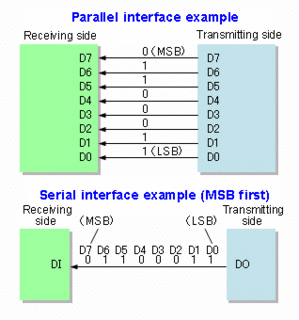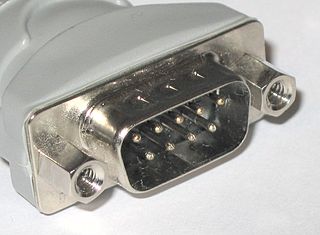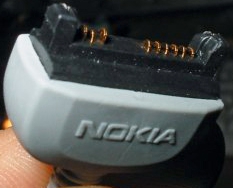Interfacing with a cell phone
The Fast Bus connection on a cell phone can be interfaced with an RS-232 serial port by building a custom cable.
| This computer science article is a stub. You can help Wikipedia by expanding it. |
Fbus (for "Fast Bus") is an ANSI/IEEE data bus protocol oriented towards backplanes and cell phones. The standard specifies a way for various pieces of electronic hardware to communicate, typically with one piece acting as master (sending a request), and another acting as a slave (returning an answer). The FBus is a bi-directional full-duplex serial type bus running at 115,200 bit/s, 8 data bits, no parity, one stop bit (8N1). Much like a standard RS-232 serial port, FBus connections use one pin for data transmit, one pin for data receive and one pin for ground.
The Fast Bus standard specifies completely the size, power requirements, signalling levels, and communications protocols for boards that live in a Fast Bus crate, which is also a part of the specification.
Fbus was developed by Nokia as an improved replacement of the Mbus, which is only half-duplex and transfers at a slower speed of 9600 bit/s.
The Fast Bus connection on a cell phone can be interfaced with an RS-232 serial port by building a custom cable.
| This computer science article is a stub. You can help Wikipedia by expanding it. |

In computer architecture, a bus is a communication system that transfers data between components inside a computer, or between computers. This expression covers all related hardware components and software, including communication protocols.
In telecommunications, RS-232, Recommended Standard 232 is a standard originally introduced in 1960 for serial communication transmission of data. It formally defines signals connecting between a DTE such as a computer terminal, and a DCE, such as a modem. The standard defines the electrical characteristics and timing of signals, the meaning of signals, and the physical size and pinout of connectors. The current version of the standard is TIA-232-F Interface Between Data Terminal Equipment and Data Circuit-Terminating Equipment Employing Serial Binary Data Interchange, issued in 1997. The RS-232 standard had been commonly used in computer serial ports and is still widely used in industrial communication devices.

Small Computer System Interface is a set of standards for physically connecting and transferring data between computers and peripheral devices. The SCSI standards define commands, protocols, electrical, optical and logical interfaces. SCSI is most commonly used for hard disk drives and tape drives, but it can connect a wide range of other devices, including scanners and CD drives, although not all controllers can handle all devices. The SCSI standard defines command sets for specific peripheral device types; the presence of "unknown" as one of these types means that in theory it can be used as an interface to almost any device, but the standard is highly pragmatic and addressed toward commercial requirements.

LocalTalk is a particular implementation of the physical layer of the AppleTalk networking system from Apple Computer.

In computing, a serial port is a serial communication interface through which information transfers in or out sequentially one bit at a time. This is in contrast to a parallel port which communicates multiple bits simultaneously in parallel. Throughout most of the history of personal computers, data was transferred through serial ports to devices such as modems, terminals, and various peripherals.

AVR is a family of microcontrollers developed since 1996 by Atmel, acquired by Microchip Technology in 2016. These are modified Harvard architecture 8-bit RISC single-chip microcontrollers. AVR was one of the first microcontroller families to use on-chip flash memory for program storage, as opposed to one-time programmable ROM, EPROM, or EEPROM used by other microcontrollers at the time.

In telecommunication and data transmission, serial communication is the process of sending data one bit at a time, sequentially, over a communication channel or computer bus. This is in contrast to parallel communication, where several bits are sent as a whole, on a link with several parallel channels.
GeoPort is a serial data system used on some models of the Apple Macintosh that could be externally clocked to run at a 2 Mbit/s data rate. GeoPort slightly modified the existing Mac serial port pins to allow the computer's internal DSP hardware or software to send data that, when passed to a digital-to-analog converter, emulated various devices such as modems and fax machines. GeoPort could be found on late-model 68K-based machines as well as many pre-USB Power Macintosh models. Some later Macintosh models also included an internal GeoPort via an internal connector on the Communications Slot. Apple GeoPort technology is now obsolete, and modem support is typically offered through USB.
RS-422, also known as TIA/EIA-422, is a technical standard originated by the Electronic Industries Alliance that specifies electrical characteristics of a digital signaling circuit. It was intended to replace the older RS-232C standard with a standard that offered much higher speed, better immunity from noise, and longer cable lengths. RS-422 systems can transmit data at rates as high as 10 Mbit/s, or may be sent on cables as long as 1,500 meters at lower rates. It is closely related to RS-423, which used the same signaling systems but on a different wiring arrangement.
The Serial Peripheral Interface (SPI) is a synchronous serial communication interface specification used for short-distance communication, primarily in embedded systems. The interface was developed by Motorola in the mid-1980s and has become a de facto standard. Typical applications include Secure Digital cards and liquid crystal displays.

The D-subminiature or D-sub is a common type of electrical connector. They are named for their characteristic D-shaped metal shield. When they were introduced, D-subs were among the smallest connectors used on computer systems.

Null modem is a communication method to directly connect two DTEs using an RS-232 serial cable. The name stems from the historical use of RS-232 cables to connect two teleprinter devices or two modems in order to communicate with one another; null modem communication refers to using a crossed-over RS-232 cable to connect the teleprinters directly to one another without the modems. It is also used to serially connect a computer to a printer, since both are DTE, and is known as a Printer Cable.
JTAG is an industry standard for verifying designs and testing printed circuit boards after manufacture.

IEEE 1284 is a standard that defines bi-directional parallel communications between computers and other devices. It was originally developed in the 1970s by Centronics, and was widely known as the Centronics port, both before and after its IEEE standardization.
RS-485, also known as TIA-485(-A) or EIA-485, is a standard defining the electrical characteristics of drivers and receivers for use in serial communications systems. Electrical signaling is balanced, and multipoint systems are supported. The standard is jointly published by the Telecommunications Industry Association and Electronic Industries Alliance (TIA/EIA). Digital communications networks implementing the standard can be used effectively over long distances and in electrically noisy environments. Multiple receivers may be connected to such a network in a linear, multidrop bus. These characteristics make RS-485 useful in industrial control systems and similar applications.
In computer engineering and electrical engineering, bit banging is slang for any method of data transmission which employs software as a substitute for dedicated hardware to generate transmitted signals or process received signals. Software directly sets and samples the states of GPIOs, and is responsible for meeting all timing requirements and protocol sequencing of the signals. In contrast to bit banging, dedicated hardware satisfies these requirements and, if necessary, provides a data buffer to relax software timing requirements. Bit banging can be implemented at very low cost, and is commonly used in embedded systems.

The Pop-Port interface was a proprietary plug-in port for accessories and data synchronisation, available with many Nokia mobile phones. The port consists of one metal pin on either end, and a plastic tab containing thirteen contacts. Pop-Port-like interfaces first appeared in Nokia phones since circa 1996, but the Pop-Port was standardised as a single interface in 2002.

The PS/2 port is a 6-pin mini-DIN connector used for connecting keyboards and mice to a PC compatible computer system. Its name comes from the IBM Personal System/2 series of personal computers, with which it was introduced in 1987. The PS/2 mouse connector generally replaced the older DE-9 RS-232 "serial mouse" connector, while the PS/2 keyboard connector replaced the larger 5-pin/180° DIN connector used in the IBM PC/AT design. The PS/2 keyboard port is electrically and logically identical to the IBM AT keyboard port, differing only in the type of electrical connector used. The PS/2 platform introduced a second port with the same design as the keyboard port for use to connect a mouse; thus the PS/2-style keyboard and mouse interfaces are electrically similar and employ the same communication protocol. However, unlike the otherwise similar Apple Desktop Bus connector used by Apple, a given system's keyboard and mouse port may not be interchangeable since the two devices use different sets of commands and the device drivers generally are hard-coded to communicate with each device at the address of the port that is conventionally assigned to that device.
This article provides information about the physical aspects of Universal Serial Bus, USB: connectors, cabling, and power. The initial versions of the USB standard specified connectors that were easy to use and that would have acceptable life spans; revisions of the standard added smaller connectors useful for compact portable devices. Higher-speed development of the USB standard gave rise to another family of connectors to permit additional data paths. All versions of USB specify cable properties; version 3.X cables include additional data paths. The USB standard included power supply to peripheral devices; modern versions of the standard extend the power delivery limits for battery charging and devices requiring up to 100 watts. USB has been selected as the standard charging format for many mobile phones, reducing the proliferation of proprietary chargers.
In telecommunications, RS-366, later known as EIA-366, defines a standard for serial communications between computers and an auto dialer, which is used to dial telephones. It was intended to be used to automate the operation of modems. The standard uses the same DB25 connectors and electrical signalling standards of the well-known RS-232 standard, which RS-366 was designed to support. The CCITT had a matching standard, V.25.